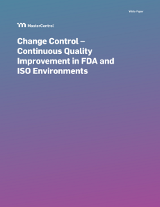
GxP Lifeline
Overview of QMS Change Management in ISO 9001:2015

ISO 9001 is one of the most recognized standards in the world. It is the basis for a variety of industry standards that define the requirements for management systems in medical device manufacturing. When the International Organization for Standardization (ISO) revised the quality management system (QMS) standard in 2015, there were significant changes to ISO 9001.1 The updated standard, ISO 9001:2015, follows a new, high-level structure, introduced new terminology, emphasized risk-based thinking, increased leadership requirements, and more.
Among changes to ISO 9001 in 2015 was an explicit requirement for risk-based thinking aimed at preventing undesirable outcomes. References to preventive action were replaced with “actions to address risks and opportunities” in ISO 9001:2015. “To achieve the benefits associated with the determination of risks and opportunities, changes may be needed,” an ISO paper on the topic states. 2
One of the goals of ISO 9001:2015 is to enhance the requirements for addressing QMS change management, according to the ISO paper.
ISO 9001:2015 Change Management
A change to a QMS may be a result of anything from customer complaints or product failures to identified opportunities for improvement or innovation. Change management is a systematic approach to dealing with such change.
In ISO 9001:2015, QMS change management is specifically addressed in multiple requirements of the standard, including:
- Clause 6.3: Planning of Changes - When the organization determines the need for changes to the QMS, the changes must be carried out in a planned manner.
- Clause 8.1: Operational Planning and Control - The organization must control planned changes, review consequences of unintended changes, and act to prevent or mitigate adverse effects.
- Clause 8.3.6: Design and Development Changes - During design and development, identified changes must be reviewed and controlled to ensure no adverse impact to product/service conformity.
- Clause 8.5.6: Control of Changes - The organization must review and control changes for production or service provision to ensure continuing conformity with requirements.
Additional references to QMS change management can be found in other ISO 9001:2015 clauses, such as those describing organizational roles and responsibilities, management review, changes to requirements for products and services, and others.
4 Common Steps for Implementing QMS Change Management
Whether QMS changes relating to inputs, activities, controls, measurements, outputs, or other parts of the process, QMS change management often involves some key steps:
-
Define the change and have a plan.
Determine what is changing, the reason for the change, when is it changing, how the change will be managed, who must adopt the change, and who will be impacted by it. Determine tasks, timeline, responsibilities, budget, resources, and more.
-
Develop a communication plan.
Craft the message, taking into consideration the assumptions and risks associated with the change. Consider the appropriate people to be informed and the appropriate channel for communication. Decide on the frequency of communication, and continually engage.
-
Train people.
Ensure an adequate training program is in place to get everyone up to speed on the change and any new requirements, processes, or roles. Employee training can be an effective way to build knowledge about the change and the required competencies.
-
Implement the change.
Execute the change, measure or determine the effectiveness of the change, adjust based on lessons learned, and repeat as needed. Carefully planned QMS change management is more likely to be implemented successfully.
If change is constant, then change control is crucial. Especially in ISO environments, where uncontrolled changes could affect the safety and reliability of products and directly impact public health and safety, manufacturers must ensure that any change affecting the QMS is controlled.
To read more about managing change in ISO and other life sciences environments, download the white paper “Change Control – Continuous Quality Improvement in FDA and ISO Environments.”
Resources:
- "ISO 9001:2015: Quality Management Systems - Requirements", ISO, 2015.
- "How Change Is Addressed Within ISO 9001:2015," ISO, 2017.
Free Resource

Enjoying this blog? Learn More.
Change Control - Continuous Quality Improvements in FDA and ISO Environments
Download Now